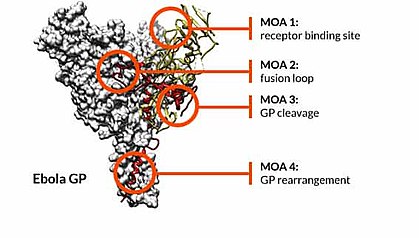
In immunology, epitope mapping is the process of experimentally identifying the binding site, or epitope, of an antibody on its target antigen (usually, on a protein).[1][2][3] Identification and characterization of antibody binding sites aid in the discovery and development of new therapeutics, vaccines, and diagnostics.[4][5][6][7][8] Epitope characterization can also help elucidate the binding mechanism of an antibody[9] and can strengthen intellectual property (patent) protection.[10][11][12] Experimental epitope mapping data can be incorporated into robust algorithms to facilitate in silico prediction of B-cell epitopes based on sequence and/or structural data.[13]
Epitopes are generally divided into two classes: linear and conformational/discontinuous. Linear epitopes are formed by a continuous sequence of amino acids in a protein. Conformational epitopes epitopes are formed by amino acids that are nearby in the folded 3D structure but distant in the protein sequence. Note that conformational epitopes can include some linear segments. B-cell epitope mapping studies suggest that most interactions between antigens and antibodies, particularly autoantibodies and protective antibodies (e.g., in vaccines), rely on binding to discontinuous epitopes.[citation needed]
- ^ DeLisser, HM (1999). "Epitope mapping". Adhesion Protein Protocols. Methods Mol Biol. Vol. 96. pp. 11–20. doi:10.1385/1-59259-258-9:11. ISBN 978-1-59259-258-6. PMID 10098119.
- ^ Davidson, E; Doranz, B (2014). "A high-throughput shotgun mutagenesis approach to mapping B-cell antibody epitopes". Immunology. 143 (1): 13–20. doi:10.1111/imm.12323. PMC 4137951. PMID 24854488.
- ^ Westwood, Olwyn M. R.; Hay, Frank C., eds. (2001). Epitope Mapping: A Practical Approach. Oxford, Oxfordshire: Oxford University Press. ISBN 978-0-19-963652-5.[page needed]
- ^ Gershoni, JM; Roitburd-Berman, A; Siman-Tov, DD; Tarnovitski Freund, N; Weiss, Y (2007). "Epitope mapping: the first step in developing epitope-based vaccines". BioDrugs. 21 (3): 145–56. doi:10.2165/00063030-200721030-00002. PMC 7100438. PMID 17516710. S2CID 29506607.
- ^ Saphire, EO (2018). "Systematic analysis of monoclonal antibodies against Ebola virus GP defines features that contribute to protection". Cell. 174 (4). et al.: P938–52. doi:10.1016/j.cell.2018.07.033. PMC 6102396. PMID 30096313.
- ^ Dutton, G (January 1, 2016). "Integral Molecular sizes up Ebola: Membrane protein specialist maps Ebola's binding sites to advance vaccine discovery". Genetic Engineering & Biotechnology News. 36 (1).
- ^ Ahmad, TA; Eweida, A; Sheweita, SA (2016). "B-cell epitope mapping for the design of vaccines and effective diagnostics". Trials in Vaccinology. 5: 71–83. doi:10.1016/j.trivac.2016.04.003.
- ^ Ahmad, TA; Eweida, A; El-Sayed, LH (2016). "T-cell epitope mapping for the design of powerful vaccines". Vaccine Reports. 6: 13–22. doi:10.1016/j.vacrep.2016.07.002.
- ^ Davidson, E; et al. (2015). "Mechanism of binding to Ebola virus glycoprotein by the ZMapp, ZMAb, and MB-003 cocktail antibodies". Journal of Virology. 89 (21): 10982–92. doi:10.1128/JVI.01490-15. PMC 4621129. PMID 26311869.
- ^ Banik, S; Deng, X; Doranz, B (2017). "Using epitope mapping to derive more value from mAbs". Genetic Engineering & Biotechnology News. 37 (15).
- ^ Cite error: The named reference
:3was invoked but never defined (see the help page). - ^ Ledford, H (2018). "Rush to protect lucrative antibody patents kicks into gear". Nature. 557 (7707): 623–624. Bibcode:2018Natur.557..623L. doi:10.1038/d41586-018-05273-z. PMID 29844545.
- ^ Potocnakova, L; Bhide, M; Pulzova, LB (2017). "An introduction to B-cell epitope mapping and in silico epitope prediction". Journal of Immunology Research. 2016: 1–11. doi:10.1155/2016/6760830. PMC 5227168. PMID 28127568.